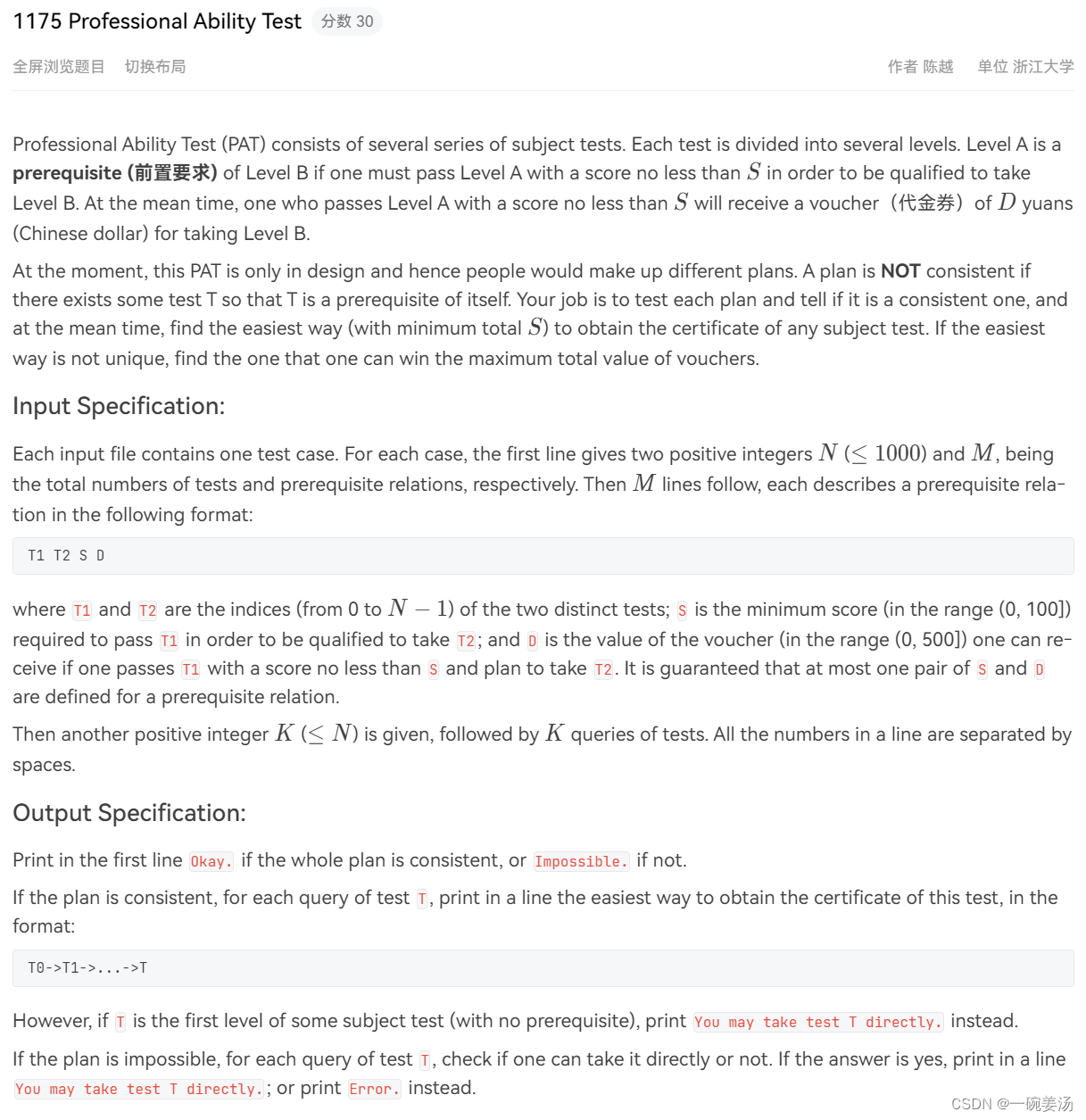【PAT甲级】1175 Professional Ability Test
发布时间:2024年01月16日

 问题思考:
问题思考:
- 首先,若所有的计划(plan)中的节点都可达,则输出 Okay
,否则输出 Impossible。注意:这里的“plan”判断的是整个图(这里是有向图)上的节点,而不只是那K个queries节点。若存在环,则必然在经历一趟拓扑排序之后,还有留存节点未能遍历到,即判断环内有节点不可达。 - 其次,每个query对应输出最佳plan,要求S(score?)最少的基础上多争取D(voucher)。这里的麻烦在于,如何化成一个单源最短路问题(这里显然可能存在多个
节点是没有前置要求的,即“You may take test i?directly”的,即“多源”的最短路)?—— 一个技巧性的做法就是,额外设置一个起点(与所有?
?节点直接相连),并求该点到整个图上的节点的单源最短路问题。
- 并用一个Last数组在每选出一条最短路边的时候记录上个节点,用来到时候追溯回去,一直追溯到预设的起点。因为该起点和所有的?
?节点直接相连,所以,求所有?
?节点到query节点的最短路中的最短路,等价于求该起点到queiry节点的最短路。
- 若先输出Okay,则之后根据Last数组输出each query节点的最短路
- 若先输出Impossible,之后只需判断query是否直接可达无需前置要求,否则输出Error。
代码实现:
#include<iostream>
#include<vector>
#include<queue>
using namespace std;
int n, m, k, in[1005], in2[1005], f, last[1005];
struct node {
int v, score, voucher;
bool operator < (const node &x) const {
if (score != x.score) return score > x.score;
return voucher < x.voucher;
}
};
struct edge {
int next, s, d;
};
vector<edge> E[1005]; // 邻接表的简洁表示
queue<int> que;
vector<pair<int, int>> dis(1002, {2e9, -1});
bool circle() {
vector<int> S;
while (que.size()) {
int now = que.front();
que.pop();
S.push_back(now);
for (auto x : E[now]) {
in2[x.next]--;
if (!in2[x.next]) que.push(x.next);
}
}
return S.size() == n;
}
void dijkstra() {
vector<int> vis(1005);
priority_queue<node> Q;
Q.push({1002, 0, 0});
while (Q.size()) {
node now = Q.top();
Q.pop();
if (vis[now.v]) continue;
vis[now.v] = 1;
dis[now.v].first = now.score;
dis[now.v].second = now.voucher;
for (auto x : E[now.v]) {
if (vis[x.next]) continue;
if (dis[x.next].first > dis[now.v].first + x.s ||
((dis[x.next].first == dis[now.v].first + x.s)
&& (dis[x.next].second < dis[now.v].second + x.d))) {
dis[x.next].first = dis[now.v].first + x.s;
dis[x.next].second = dis[now.v].second + x.d;
last[x.next] = now.v;
Q.push({x.next, dis[x.next].first, dis[x.next].second});
}
}
}
return ;
}
int main() {
cin >> n >> m;
for (int i = 0; i < m; i++) {
int a, b, s, d;
scanf("%d%d%d%d", &a, &b, &s, &d);
// 构建邻接表
E[a].push_back(edge{b, s, d});
in[b]++, in2[b]++;
}
// 寻找无前置要求的节点
for (int i = 0; i < n; i++) {
if (in[i] == 0) {
E[1002].push_back({i, 0, 0}); // 起点与无前置要求的节点相连
que.push(i);
}
}
f = circle();
dijkstra();
cin >> k;
if (f) cout << "Okay.\n";
else cout << "Impossible.\n";
for (int i = 0, q; i < k; i++) {
scanf("%d", &q);
if (!in[q]) cout << "You may take test " << q << " directly.\n";
else if (!f) cout << "Error.\n";
else {
vector<int> path;
while (q != 1002) {
path.push_back(q);
q = last[q];
}
for (int j = path.size() - 1; j >= 0; j--) {
cout << path[j];
j && cout << "->";
}
cout << '\n';
}
}
return 0;
}知识点:小于号重载
- 这里需要注意,重载小于号的方向,下面是一个实验样例。
#include<iostream>
#include<vector>
#include<queue>
struct node {
int v, score, voucher;
bool operator < (const node &x) const {
if (score != x.score) return score > x.score;
return voucher < x.voucher;
}
};
int main() {
priority_queue<node> que;
que.push(node{0, 1, 2});
que.push(node{1, 1, 3});
que.push(node{2, 2, 2});
while (que.size()) {
node now = que.top(); que.pop();
cout << "now : " << now.v << " " << now.score << " " << now.voucher << endl;
}
return 0;
}- 运行结果:?
now : 1 1 3
now : 0 1 2
now : 2 2 2可见如果想要让自定义结构满足按其某个property从小到大排序,就得这么写:
bool operator < (const node &x) const {
return this.property > x.property
}
文章来源:https://blog.csdn.net/weixin_55252589/article/details/135442248
本文来自互联网用户投稿,该文观点仅代表作者本人,不代表本站立场。本站仅提供信息存储空间服务,不拥有所有权,不承担相关法律责任。 如若内容造成侵权/违法违规/事实不符,请联系我的编程经验分享网邮箱:chenni525@qq.com进行投诉反馈,一经查实,立即删除!
本文来自互联网用户投稿,该文观点仅代表作者本人,不代表本站立场。本站仅提供信息存储空间服务,不拥有所有权,不承担相关法律责任。 如若内容造成侵权/违法违规/事实不符,请联系我的编程经验分享网邮箱:chenni525@qq.com进行投诉反馈,一经查实,立即删除!
最新文章
- Python教程
- 深入理解 MySQL 中的 HAVING 关键字和聚合函数
- Qt之QChar编码(1)
- MyBatis入门基础篇
- 用Python脚本实现FFmpeg批量转换
- 快速入门学会tomcat!
- 【计算机组成原理】IEEE 754 标准定义的浮点数表示格式
- 什么是API网关代理?
- 如何实现对存储在MinIO上的数据的高效搜索与查询
- 一、基础数据结构——2.队列——1.STL queue
- windows编译TensorFlowServing
- element-ui table-自定义表格某列的表头样式或者功能
- Note: An Interesting Festival
- EasyExcel与Lombok的@Accessors注解的冲突
- 阿里云服务器固定带宽下载和上传速度对照表